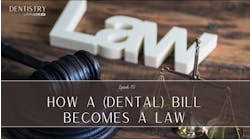The 5 essentials of a superb chairside manner
Dear Dianne,
Since buying my practice from a retiring dentist three years ago, patient attrition has been a problem. There were about 1,500 active patients when I purchased the practice, but now there are only about 1,000 active patients. I think one of the problems is that I’m a shy and introverted person, and chit chat feels awkward and uncomfortable for me. The previous owner was very outgoing and well-liked. My business assistant has shared with me that a few patients who have left told her that they did not like me. I’ve read a number of articles about “connecting” with patients, but I find this very difficult. I do love my work and feel I’m a good dentist.
Signed,
Dr. John
Dear Dr. John,
You should be very concerned that you’ve lost one-third of your patient base over a three-year period. If something doesn’t change, your practice will not stay afloat.
Every practice experiences some attrition through natural factors, such as patients relocating, third-party payment issues, or death. Nevertheless, most experts agree that every practice needs a steady flow of new patients each month to stay healthy, usually about 20 new patients per doctor.
It sounds like you need to work on your chairside manner. Here are the five essentials to help you do just that.
Look
Eye contact is vitally important in establishing an effective communication bond. Never stand behind your patients while talking with them. In addition, make sure the chair is upright and that you are seated when explaining something to a patient. People feel vulnerable when they are reclined. Keep your eye level in line with your patients so as not to speak “down” to them.
Listen
Effective communicators have the ability to “read” other persons. This ability is gained through listening and internalizing the feelings of those being listened to.
Linger
In order for this concept to be workable, there must be good schedule control. The way you leave the operatory is important in helping a patient form a positive memory of the appointment.
Touch
An appropriate touch to a patient conveys warmth and caring. A playful pat on the head of a child, sincere handshakes with male patients, or a pat on the arm or shoulder of a female patient conveys that you genuinely care. You may have to step out of your comfort zone to use touch as a display of caring to your patients. But an appropriate touch to a patient can be quite effective in conveying warmth.
Identify
The ability to identify with what your patients are feeling is very important in establishing good communications. If you see your patients as total beings and not just a set of teeth, you will be more successful at establishing the trust that is essential in any good doctor/patient relationship.
In addition to improving your chairside manner, you need to engage in marketing that’s aimed at strengthening your patient base and bringing in new patients. However, getting new patients through the door will not help you if they do not stay. Connecting with them keeps them coming back.
People generally do not enjoy dental visits, and if they misinterpret your shyness as arrogance or aloofness, they will not form a good opinion of you. The big five—look, listen, linger, touch, and identify—are the essence of developing a superb chairside manner. Sharing long-term friendly patient relationships can be one of the most fulfilling aspects of your professional career.
If you are not able to turn this around on your own, please get help. You may need an objective practice management consultant to work with you one-on-one to improve your chairside manner and marketing strategy.
Dianne Glasscoe Watterson, MBA, RDH, is a consultant, speaker, and author. She helps good practices become better through practical analysis and teleconsulting. Visit her website at wattersonspeaks.com. For consulting or speaking inquiries, contact Watterson at [email protected] or call (336) 472-3515.







